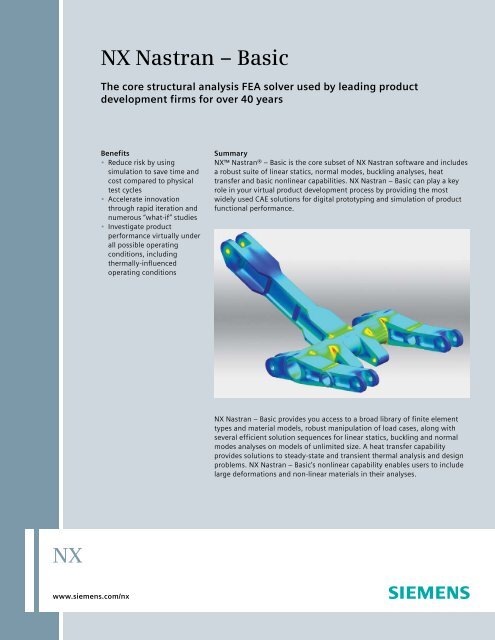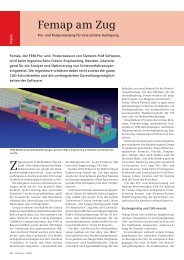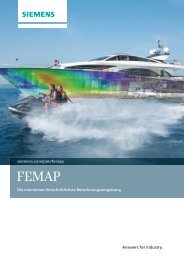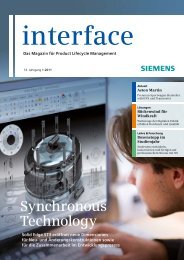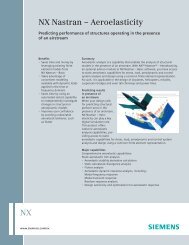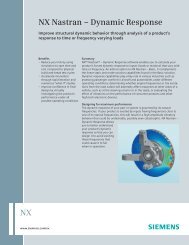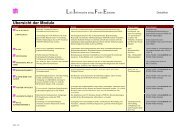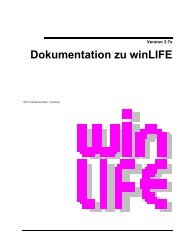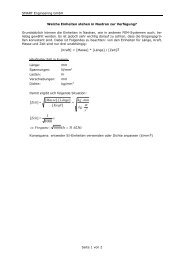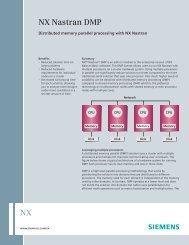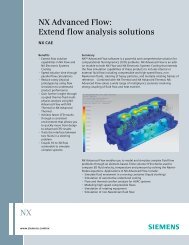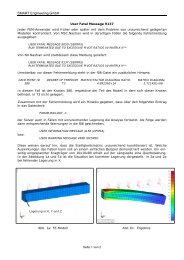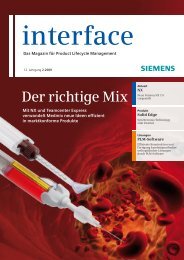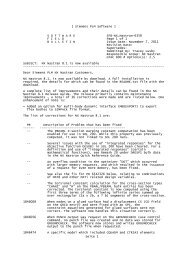NX Nastran Basic Fact Sheet.pdf - Maya HTT
NX Nastran Basic Fact Sheet.pdf - Maya HTT
NX Nastran Basic Fact Sheet.pdf - Maya HTT
Create successful ePaper yourself
Turn your PDF publications into a flip-book with our unique Google optimized e-Paper software.
<strong>NX</strong> <strong>Nastran</strong> – <strong>Basic</strong><br />
The core structural analysis FEA solver used by leading product<br />
development firms for over 40 years<br />
Benefits<br />
• Reduce risk by using<br />
simulation to save time and<br />
cost compared to physical<br />
test cycles<br />
• Accelerate innovation<br />
through rapid iteration and<br />
numerous “what-if” studies<br />
• Investigate product<br />
performance virtually under<br />
all possible operating<br />
conditions, including<br />
thermally-influenced<br />
operating conditions<br />
Summary<br />
<strong>NX</strong> <strong>Nastran</strong>® – <strong>Basic</strong> is the core subset of <strong>NX</strong> <strong>Nastran</strong> software and includes<br />
a robust suite of linear statics, normal modes, buckling analyses, heat<br />
transfer and basic nonlinear capabilities. <strong>NX</strong> <strong>Nastran</strong> – <strong>Basic</strong> can play a key<br />
role in your virtual product development process by providing the most<br />
widely used CAE solutions for digital prototyping and simulation of product<br />
functional performance.<br />
<strong>NX</strong> <strong>Nastran</strong> – <strong>Basic</strong> provides you access to a broad library of finite element<br />
types and material models, robust manipulation of load cases, along with<br />
several efficient solution sequences for linear statics, buckling and normal<br />
modes analyses on models of unlimited size. A heat transfer capability<br />
provides solutions to steady-state and transient thermal analysis and design<br />
problems. <strong>NX</strong> <strong>Nastran</strong> – <strong>Basic</strong>’s nonlinear capability enables users to include<br />
large deformations and non-linear materials in their analyses.<br />
<strong>NX</strong><br />
www.siemens.com/nx
<strong>NX</strong><br />
<strong>NX</strong> <strong>Nastran</strong> – <strong>Basic</strong><br />
Solution types supported by<br />
<strong>NX</strong> <strong>Nastran</strong> - <strong>Basic</strong><br />
SOL<br />
Number SOL<br />
Name<br />
Description<br />
101 SESTATIC Linear statics<br />
103 SEMODES Normal modes<br />
105 SEBUCKL Buckling<br />
106 NLSTATIC Nonlinear or<br />
linear statics<br />
114 CYCSTATX Cyclic statics<br />
115 CYCMODE Cyclic normal<br />
modes<br />
116 CYCBUCKL Cyclic buckling<br />
129 NLTRAN Nonlinear or<br />
linear transient<br />
response<br />
153 NLSCSH Static structural<br />
and/or steady state<br />
heat transfer<br />
analysis<br />
159 NLTCSH Transient structural<br />
and/or transient<br />
heat transfer<br />
analysis<br />
Start simply, add as your needs evolve<br />
<strong>NX</strong> <strong>Nastran</strong> – <strong>Basic</strong> will allow you to<br />
initiate digital simulation into your product<br />
development process by providing access<br />
to a broad library of finite element types<br />
and material models, robust manipulation<br />
of load cases, along with several efficient<br />
solution sequences for linear statics<br />
(including buckling) and normal modes<br />
analyses on models of unlimited size. You<br />
can also perform sensitivity studies based<br />
on these analysis types. <strong>NX</strong> <strong>Nastran</strong>’s<br />
powerful analysis capabilities will provide<br />
you with the tools you need for:<br />
• Linear statics, including inertia relief<br />
• Normal modes<br />
• Buckling<br />
• Design sensitivity (statics, modes,<br />
buckling)<br />
• Model checkout<br />
• Heat transfer<br />
• <strong>Basic</strong> nonlinear<br />
• Coupled structure/acoustic modes<br />
<strong>NX</strong> <strong>Nastran</strong> – <strong>Basic</strong> includes a complete<br />
element library including 1D, 2D and 3D<br />
low- and higher-order elements; scalar and<br />
special elements including spot weld as<br />
well as p-elements (that can be combined<br />
with other elements).<br />
Table 1 – Element types supported by <strong>NX</strong> <strong>Nastran</strong> – <strong>Basic</strong><br />
Element<br />
type<br />
Element<br />
name<br />
Description<br />
Scalar ELAS Scalar spring (several variations)<br />
MASS Scalar mass (several variations)<br />
1D BAR Simple beam element<br />
BEAM Complex beam element including shear center offset and<br />
variable cross section<br />
BEND Curved beam, pipe or elbow<br />
ROD Rod element tension-compression-torsion element<br />
CONROD<br />
TUBE<br />
2D QUAD4 Quadrilateral plate with membrane-bending or plane<br />
strain behavior<br />
QUAD8 Higher-order quadrilateral shell element<br />
QUADR Quadrilateral membrane or shell<br />
SHEAR Shear panel<br />
TRIA3 Triangular plate with membrane-bending or plain strain behavior<br />
TRIA6 Higher-order triangular shell element<br />
TRIA Triangular membrane or shell<br />
CPLSTN3 Plane strain triangular element connection<br />
CPLSTN6 Plane strain high-order triangular element connection<br />
CPLSTN4 Plane strain quadrilateral element connection<br />
CPLSTN8 Plane strain high-order quadrilateral element connection<br />
CPLSTS3 Plane stress triangular element connection<br />
CPLSTS6 Plane stress high-order triangular element connection<br />
CPLSTS4 Plane stress quadrilateral element connection<br />
CPLSTS8 Plane stress high-order quadrilateral element connection<br />
3D HEXA Six-sided solid element with 8-20 grid points<br />
PENTA Five-sided solid element with 6-15 grid points<br />
TETRA Four-sided solid element with 4-10 grid points<br />
PYRAMID 5-sided solid element with 5-13 grid points<br />
Rigid RBAR Rigid bar element<br />
RBE1 Rigid body connected to an arbitrary number of grid points<br />
RBE2 Rigid body with independent DOFs at a grid point and dependent<br />
DOFs at an arbitrary number of grid points<br />
RROD Pin-ended rigid rod<br />
RTRPLT Rigid triangular plate<br />
Interpolation RBE3<br />
RSPLINE<br />
Defines motion of a reference point as the weighted average<br />
of the motions at a set of grid points<br />
Multipoint constraints for the interpolation of displacements<br />
at grid points<br />
Composites BEAM Complex beam element<br />
QUAD4 Quadrilateral plate<br />
QUAD8 Higher-order quadrilateral plate<br />
QUADR Quadrilateral plate<br />
TRIA3 Triangular plate<br />
TRIA6 Higher-order triangular plate<br />
TRIAR Triangular plate<br />
CHEXA Six-sided solid element with 8-20 grid points<br />
CPENTA Five-sided solid element with 6-15 grid points<br />
p-elements HEXA Six-sided solid element with 8-20 grid points<br />
PENTA Five-sided solid element with 6-15 grid points<br />
TETRA Four-sided solid element with 4-10 grid points
<strong>NX</strong><br />
Table 1 (continued)<br />
Element type Element name Description<br />
Axisymmetric CONEAX Conical shell<br />
TRIAX6<br />
Triangular cross section ring<br />
CTRAX3 Triangle<br />
CTRAX6 Higher order triangle<br />
CQUADX4 Quad<br />
CQUADX8 Higher order quad<br />
Crack tip CRAC2D Two-dimensional crack tip element<br />
CRAC3D Three-dimensional crack tip element<br />
General CONM1 6-b-6 symmetric mass matrix<br />
CONM2<br />
Concentrated mass with offsets<br />
DMI<br />
Direct matrix input<br />
GENEL<br />
General element<br />
Weld CWELD Weld connection element<br />
Fastener CFAST Fastener element for shell patch connection<br />
<strong>NX</strong> <strong>Nastran</strong> – <strong>Basic</strong> provides a<br />
full range of material models:<br />
isotropic, orthotropic, anisotropic and<br />
temperature-dependent. It also allows<br />
for easy combination (or addition)<br />
of load cases, such as point, line and<br />
surface loads on elements; loads<br />
applied directly to geometry; thermal<br />
loads; enforced deformation; and<br />
weighted combinations of each type.<br />
Table 2 – Static loading types in <strong>NX</strong> <strong>Nastran</strong> – <strong>Basic</strong><br />
Load type Load name Description<br />
Point FORCE Concentrated force (several variations)<br />
MOMENT Concentrated moment (several variations)<br />
Curve GMLOAD Load distributed along a geometric curve<br />
PLOAD1 Concentrated, uniform or linear load applied to 1D<br />
elements<br />
Edge PLOADE1 Edge Load on Plane Strain and Plane Stress Elements<br />
Surface GMLOAD Load distributed along a geometric surface<br />
PLOAD<br />
Pressure load applied to 2D elements or the face of 3D<br />
elements (several variations)<br />
Volume GRAV Steady-state acceleration vectors<br />
RFORCE<br />
Angular velocity or acceleration<br />
ACCEL<br />
Spatial varying acceleration load<br />
Bolt preload BOLTFOR Bolt preload applied to beam elements<br />
Enforced GMBC Enforced displacements for geometry<br />
motion (curves motion and surfaces)<br />
GMSPC<br />
Constraints applied to geometry<br />
SPC<br />
Constraints applied to grid points<br />
(several variations)<br />
Thermal TEMP Temperatures applied to grid points<br />
(several variations)<br />
TEMPP1 2D element temperature field<br />
TEMPRB 1D element temperature field
<strong>NX</strong><br />
Table 2 (continued)<br />
Load type Load name Description<br />
Axisymmetric FORCEAX Concentrated force<br />
MOMAX Concentrated moment<br />
PLOAD1X Surface traction<br />
PRESAX Pressure loading<br />
SPCAX Constraints<br />
TEMPAX Applied temperatures<br />
General DMI Direct matrix input<br />
Combination LOAD Combine load sets<br />
Non-structural mass NSM Non-structural mass sets<br />
<strong>NX</strong> <strong>Nastran</strong> – <strong>Basic</strong> provides several nonelemental<br />
approaches for connecting<br />
meshes and transferring loads. This can<br />
greatly simplify modeling procedures.<br />
Table 3 – Non-elemental mesh connections in <strong>NX</strong> <strong>Nastran</strong> – <strong>Basic</strong><br />
Type Name Description<br />
Constraint MPC Constraint equations used to connect<br />
specified degrees-of-freedom<br />
RSSCON Constraint relation to connect shell to<br />
solid elements<br />
Contact BSURF A set of shell element faces that define<br />
a contact surface<br />
BSURFS A set of solid element faces that define<br />
a contact surface<br />
BCTSET Pairs of contact surfaces that can contact<br />
in a linear static solution<br />
Glue BSURF A set of shell element faces that define a<br />
glue surface<br />
BSURFS A set of solid element faces that define a<br />
glue surface<br />
BGSET Pairs of glue surfaces that are in connection<br />
in any solution type<br />
BLSEG Defines a glue or contact edge region,<br />
or a curve for slideline contact<br />
Additional capabilities for linear static<br />
and Eigenvalue solutions<br />
Linear static solutions<br />
• Edge-to-surface contact to glue the<br />
edges of shell elements to the faces of<br />
solid or shell elements<br />
• Surface-to-surface contact for shell and<br />
solid elements<br />
• Inertia relief for unrestrained models<br />
• Element-based iterative solver for very<br />
fast solutions of tetrahedron meshed<br />
models<br />
• Bolt preload effects<br />
• Thermal expansion for rigid elements<br />
Normal mode solutions<br />
• Lanczos<br />
• Residual vectors for residual flexibility<br />
• Differential stiffness effects<br />
• Unconstrained model solutions<br />
• Solution about a contact condition<br />
• Export modes to ADAMS or RecurDyn<br />
Design sensitivity analysis for assessing<br />
design changes<br />
• Shape and sizing design variables<br />
• Preset objective and constraints<br />
• Weight, volume<br />
• Element stress, strain, force<br />
• Displacement, rotation, reaction force<br />
• Normal modes Eigenvalue<br />
• Buckling load factor<br />
• Composites: lamina strain, force and<br />
failure index<br />
• User-defined objective and constraints<br />
• Efficient handling of hundreds of design<br />
variables, constraints and load cases<br />
buckling in a single run
<strong>NX</strong><br />
Efficient solvers<br />
• Sparse matrix solvers for faster speed<br />
and minimal disk space usage<br />
• Automatic internal resequencing for<br />
bandwidth reduction<br />
• Restarts to take advantage of previously<br />
computed solutions<br />
Steady-state and transient<br />
thermal analysis<br />
<strong>NX</strong> <strong>Nastran</strong> – <strong>Basic</strong> provides heat transfer<br />
solutions to steady-state and transient<br />
thermal analysis design problems. This<br />
capability may also be used in combination<br />
with <strong>NX</strong> <strong>Nastran</strong> structural analyses to<br />
perform thermal stress analysis.<br />
If changes in temperature and the flow of<br />
heat within your product could affect its<br />
performance, heat transfer should play a<br />
key role in your digital simulation process.<br />
Heat transfer can span the full range from<br />
system-level analysis of global energy<br />
balances to the detailed analysis associated<br />
with temperature and thermal stress limit<br />
levels. It allows you to investigate linear or<br />
nonlinear problems, steady-state or<br />
transient effects, as well as all three types<br />
of heat transfer (conduction, convection<br />
and radiation), displaying the<br />
characteristics associated with each.<br />
Heat conduction<br />
• Temperature-dependent conductivity<br />
• Temperature-dependent specific heat<br />
• Anisotropic thermal conductivity<br />
• Latent heat of phase change<br />
• Temperature-dependent internal heat<br />
generation<br />
• Weighted temperature gradientdependent<br />
internal heat generation<br />
• Time-dependent internal heat generation<br />
Free convection boundaries<br />
• Temperature-dependent heat transfer<br />
coefficient<br />
• Weighted temperature gradientdependent<br />
heat transfer coefficient<br />
• Time-dependent heat transfer<br />
coefficient<br />
• Nonlinear functional forms<br />
• Weighted film temperatures<br />
Forced convection<br />
• Tube fluid flow field relationships<br />
• Temperature-dependent fluid viscosity,<br />
conductivity and specific heat<br />
• Time-dependent mass flow rate<br />
• Temperature-dependent mass flow rate<br />
• Weighted temperature gradientdependent<br />
mass flow rate<br />
Radiation to space<br />
• Temperature-dependent and<br />
wavelength-dependent emissivity<br />
• Diffuse 3D view factor calculations with<br />
self and third-body shadowing<br />
• Adaptive view factor calculations<br />
• Net view factors<br />
• User-supplied exchange factors<br />
• Radiation matrix control<br />
• Multiple radiation enclosures<br />
Applied heat loads<br />
• Direction and surface normal heat flux<br />
• Grid point nodal power<br />
• Temperature-dependent and weighted<br />
gradient-dependent heat flux<br />
• Time-dependent heat flux<br />
• Temperature boundary conditions<br />
• Temperature initial conditions<br />
<strong>Basic</strong> nonlinear analysis<br />
<strong>NX</strong> <strong>Nastran</strong> – <strong>Basic</strong> enables you to analyze<br />
models with geometric nonlinearities; that<br />
is, large deformations or with material<br />
nonlinearities. Point-to-point contact<br />
nonlinearity can also be simulated. This<br />
basic nonlinear capability allows users to<br />
evaluate whether the small displacement<br />
and linear material assumptions used in<br />
linear analysis are accurate.<br />
Geometric nonlinear behavior<br />
• Large deformations<br />
• Large strain for hyperelastic material<br />
• Snap-through analysis (post-buckling)<br />
Material nonlinear behavior<br />
• Plasticity<br />
• Hyperelasticity<br />
• Thermoelasticity<br />
• Viscoelasticity (creep)<br />
Automated solution methods – statics<br />
• Load control method<br />
• Displacement control method<br />
• Adaptive load increment<br />
Other features<br />
• Static and transient solutions<br />
• Restart analysis<br />
• Identical element types in linear and<br />
nonlinear analysis<br />
• Point-to-point contact with gap elements<br />
Contact<br />
Siemens PLM Software<br />
Americas 800 498 5351<br />
Europe 44 (0) 1276 702000<br />
Asia-Pacific 852 2230 3333<br />
www.siemens.com/nx<br />
© 2010 Siemens Product Lifecycle Management Software<br />
Inc. All rights reserved. Siemens and the Siemens logo are<br />
registered trademarks of Siemens AG. D-Cubed, Femap,<br />
Geolus, GO PLM, I-deas, Insight, Jack, JT, <strong>NX</strong>, Parasolid,<br />
Solid Edge, Teamcenter, Tecnomatix and Velocity Series are<br />
trademarks or registered trademarks of Siemens Product<br />
Lifecycle Management Software Inc. or its subsidiaries in<br />
the United States and in other countries. All other logos,<br />
trademarks, registered trademarks or service marks used<br />
herein are the property of their respective holders.<br />
X7 2661 10/11 A


